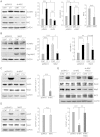MAZ mediates the cross-talk between CT-1 and NOTCH1 signaling during gliogenesis
- PMID: 26867947
- PMCID: PMC4751466
- DOI: 10.1038/srep21534
MAZ mediates the cross-talk between CT-1 and NOTCH1 signaling during gliogenesis
Erratum in
-
Corrigendum: MAZ mediates the cross-talk between CT-1 and NOTCH1 signaling during gliogenesis.Sci Rep. 2016 Mar 29;6:23309. doi: 10.1038/srep23309. Sci Rep. 2016. PMID: 27023055 Free PMC article. No abstract available.
Abstract
Neurons and glia cells are differentiated from neural stem/progenitor cells (NSCs/NPCs) during brain development. Concomitant activation of JAK/STAT and NOTCH1 signaling is required for gliogenesis, a process to generate glia cells to ensure proper brain functions. NOTCH1 signaling is down-regulated during neurogenesis and up-regulated during gliogenesis. However, the underlying mechanism remains elusive. We report here that cardiotrophin-1 (CT-1) activates NOTCH1 signaling through the up-regulation of ADAM10, a rate-limiting factor of NOTCH1 signaling activation. We found that a transcriptional factor, Myc-associated zinc finger protein (MAZ), plays an important role in ADAM10 transcription in response to CT-1 in NPCs. MAZ knockdown inhibits CT-1 stimulated gliogenesis and it can be rescued by over-expressing human NICD. Our results provide a link between NOTCH1 activation and neuronal secreted CT-1, suggesting that CT-1 plays an important role in ensuring the coordinated activation of NOTCH1 signaling during gliogenesis.
Figures






Similar articles
-
Mapping spatio-temporal activation of Notch signaling during neurogenesis and gliogenesis in the developing mouse brain.J Neurochem. 2004 Jul;90(1):142-54. doi: 10.1111/j.1471-4159.2004.02470.x. J Neurochem. 2004. PMID: 15198674
-
ADAM10 and Notch1 on murine dendritic cells control the development of type 2 immunity and IgE production.Allergy. 2018 Jan;73(1):125-136. doi: 10.1111/all.13261. Epub 2017 Aug 31. Allergy. 2018. PMID: 28745029 Free PMC article.
-
Notch1 signaling regulates radial glia differentiation through multiple transcriptional mechanisms.J Neurosci. 2006 Mar 22;26(12):3102-8. doi: 10.1523/JNEUROSCI.4829-05.2006. J Neurosci. 2006. PMID: 16554461 Free PMC article.
-
MicroRNA-197 controls ADAM10 expression to mediate MeCP2's role in the differentiation of neuronal progenitors.Cell Death Differ. 2019 Oct;26(10):1863-1879. doi: 10.1038/s41418-018-0257-6. Epub 2018 Dec 18. Cell Death Differ. 2019. PMID: 30560934 Free PMC article.
-
Prox1 regulates the notch1-mediated inhibition of neurogenesis.PLoS Biol. 2010 Dec 21;8(12):e1000565. doi: 10.1371/journal.pbio.1000565. PLoS Biol. 2010. PMID: 21203589 Free PMC article.
Cited by
-
Cardiotrophin-1 stimulates the neural differentiation of human umbilical cord blood-derived mesenchymal stem cells and survival of differentiated cells through PI3K/Akt-dependent signaling pathways.Cytotechnology. 2017 Dec;69(6):933-941. doi: 10.1007/s10616-017-0103-6. Epub 2017 Jun 10. Cytotechnology. 2017. PMID: 28601931 Free PMC article.
-
MAZ induces MYB expression during the exit from quiescence via the E2F site in the MYB promoter.Nucleic Acids Res. 2017 Sep 29;45(17):9960-9975. doi: 10.1093/nar/gkx641. Nucleic Acids Res. 2017. PMID: 28973440 Free PMC article.
-
Regionally Distinct Astrocytes Display Unique Transcription Factor Profiles in the Adult Brain.Front Neurosci. 2020 Feb 21;14:61. doi: 10.3389/fnins.2020.00061. eCollection 2020. Front Neurosci. 2020. PMID: 32153350 Free PMC article.
-
16p11.2 transcription factor MAZ is a dosage-sensitive regulator of genitourinary development.Proc Natl Acad Sci U S A. 2018 Feb 20;115(8):E1849-E1858. doi: 10.1073/pnas.1716092115. Epub 2018 Feb 5. Proc Natl Acad Sci U S A. 2018. PMID: 29432158 Free PMC article.
-
The Dynamic Proteome of Oligodendrocyte Lineage Differentiation Features Planar Cell Polarity and Macroautophagy Pathways.Gigascience. 2020 Oct 31;9(11):giaa116. doi: 10.1093/gigascience/giaa116. Gigascience. 2020. PMID: 33128372 Free PMC article.
References
Publication types
MeSH terms
Substances
LinkOut - more resources
Full Text Sources
Other Literature Sources

